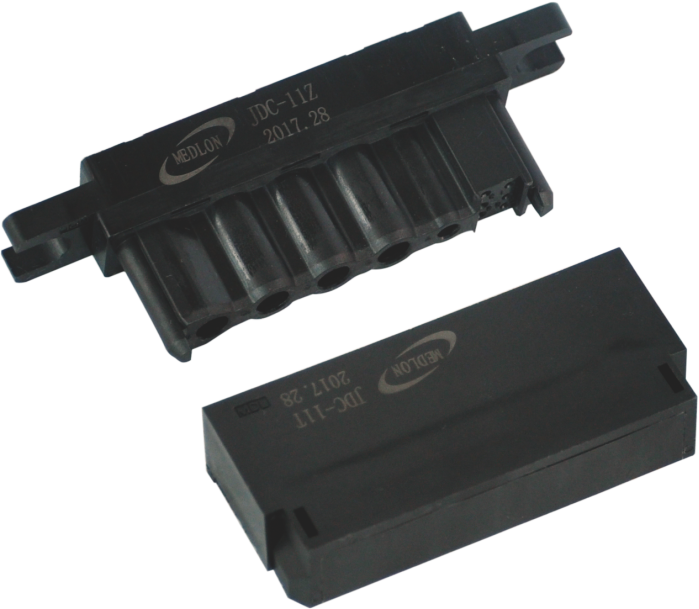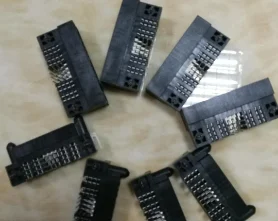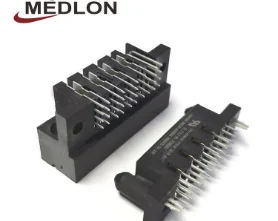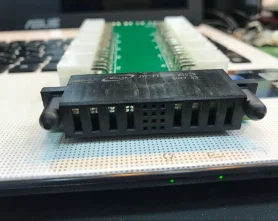



feature: Input voltage: maximum 220V, minimum 110V Output voltage: generally 5V or 12V Input current: Varies according to output voltage and load power Output power: depends on load capacity and output voltage Working frequency: generally 50Hz or 60Hz Advantage: 1. Versatility: Combination AC-DC and split power options are available, and the module can be configured to fit most designs 2. Convenient and flexible: easy to maintain and replace. 3. Safe and reliable: waterproof, dustproof and durable, 4. Quick connection: plug-in connection, can be quickly connected and disconnected, convenient for daily use 5. Multiple interface options: such as circular connectors, square connectors, threaded connectors, etc.
Specifications
| Component Type | boat power connector |
| Gender | Header/Receptacle |
| Header Pin Pattern (Left to Right) | Power/Signal |
| Number of Contacts (Power) | 4 |
| Number of Rows (Power) | 1 |
| Number of Contacts (Signal) | $keyworrd{12} |
| Number of Rows (Signal) | 7 |
| Termination Style | Solder To Board |
| Orientation | Right Angle |
| Pitch (Power) | 6.35mm (0.250in) |
| Pitch Signal) | 2.54mm (0.100in) |
| Current Rating | $keyworrd{13}A max. for One Powered Contact |
| Resistance (Power Contact) | Maximum for mated pair is 2mΩ |
| Resistance (Signal Contact) | Maximum for mated pair is 20mΩ |
| Dielectric Withstanding Voltage | $keyworrd{14}V DC for power ; $keyworrd{15}V DC for signal contacts |
| Durability (Mating cycles) | $keyworrd{16} Mating Cycles |
| Operating Temperature Range | -$keyworrd{13}°C to +125°C |
| Material Housing | PPA, glass fiber reinforce, UL94V-0 |
| Plating Contact area | 0.76μm (29.921μin) Gold |
| ail Plating (Signal) | 1.98μm (78μin) Tin |
| Tail Plating (Power) | 1.98μm (78μin) Tin |
| Guide Feature | Guide Pin Pocket |
| Packaging | Cartons or Tray |



1.About boat power connector raw materials
Power connector raw materials are typically made from metals such as copper, aluminum, and brass. These metals are chosen for their electrical conductivity, strength, and corrosion resistance. Plastics such as polycarbonate, nylon, and ABS are also used in the construction of power connectors. These materials are chosen for their durability, flexibility, and insulation properties.
2.Can boat power connectors be used in automotive or marine applications?
Our company has many years of boat power connector experience and expertise. Yes, power connectors can be used in automotive and marine applications. However, it is important to ensure that the connectors are rated for the specific application and environment.
3.Are there any special tools or techniques required for installing a boat power connector?
Our boat power connector products undergo strict quality control to ensure customer satisfaction. Yes, special tools and techniques are required for installing a power connector. Depending on the type of power connector, you may need a crimping tool, soldering iron, wire strippers, and/or heat shrink tubing. Additionally, you may need to use specific techniques such as soldering, crimping, and/or heat shrinking to ensure a secure connection.

4.Are there any safety standards that boat power connectors have to meet?
We operate our boat power connector business with integrity and honesty. Yes, power connectors must meet safety standards set by the International Electrotechnical Commission (IEC). These standards cover a range of topics, including electrical safety, mechanical strength, environmental protection, and electromagnetic compatibility.
5.How do you select the appropriate locking mechanism for a boat power connector?
1. Consider the application: The type of locking mechanism you choose should be based on the application and the environment in which the power connector will be used. For example, if the connector will be used in a harsh environment, you may want to choose a locking mechanism that is more robust and resistant to corrosion. 2. Consider the size: The size of the power connector should also be taken into account when selecting a locking mechanism. If the connector is too small, then a locking mechanism that is too large may not fit. 3. Consider the cost: The cost of the locking mechanism should also be taken into account when selecting the appropriate locking mechanism for a power connector. If the cost is too high, then it may not be feasible to use the locking mechanism. 4. Consider the safety: The safety of the power connector should also be taken into account when selecting the appropriate locking mechanism. If the locking mechanism is not secure enough, then it could lead to accidental disconnection of the power connector.
6.About boat power connector delivery date
The delivery date for power connectors will depend on the type of connector, the quantity, and the supplier. Generally, most suppliers will provide an estimated delivery date when the order is placed. If the order is urgent, some suppliers may be able to provide a faster delivery time.

7.How do you troubleshoot common issues with boat power connectors?
Being one of the top boat power connector manufacturers in China, We attach great importance to this detail. 1. Check the power source: Make sure the power source is working properly and is providing the correct voltage. 2. Check the power connector: Inspect the power connector for any signs of damage or corrosion. If the connector is damaged, replace it. 3. Check the wiring: Inspect the wiring for any signs of damage or corrosion. If the wiring is damaged, replace it. 4. Check the connection: Make sure the power connector is securely connected to the power source and the device. 5. Check the device: Make sure the device is working properly and is receiving the correct voltage. 6. Check the fuse: If the device is not receiving power, check the fuse to make sure it is not blown. If the fuse is blown, replace it.
8.Is there a specific sequence for connecting and disconnecting a boat power connector?
As one of the boat power connector market leaders, we are known for innovation and reliability. Yes, there is a specific sequence for connecting and disconnecting a power connector. The sequence is as follows: 1. Disconnect the power source from the device. 2. Disconnect the power connector from the device. 3. Inspect the power connector for any damage or corrosion. 4. Connect the power connector to the device. 5. Reconnect the power source to the device. 6. Test the device to ensure proper operation.
9.How does a boat power connector differ from a regular electrical connector?
Our mission is to provide customers with the best solutions for boat power connector. A power connector is designed to carry higher currents than a regular electrical connector. Power connectors are typically used to connect power supplies, motors, and other high-power devices. They are usually larger and sturdier than regular electrical connectors, and they often have additional safety features such as locking mechanisms and strain reliefs.

10.Are there any compatibility issues when using boat power connectors from different manufacturers?
Our boat power connector products undergo strict quality control to ensure customer satisfaction. Yes, there can be compatibility issues when using power connectors from different manufacturers. Different manufacturers may use different sizes, shapes, and pin configurations for their power connectors, which can lead to incompatibility issues. Additionally, some manufacturers may use proprietary connectors that are not compatible with other brands. It is important to check the specifications of the power connectors before purchasing to ensure compatibility.
11.About boat power connector origin
The origin of power connectors can be traced back to the early days of electricity. In the late 19th century, the first electrical connectors were developed to connect electrical devices to power sources. These connectors were made of metal and were designed to be inserted into a socket. Over time, the design of power connectors has evolved to include a variety of shapes and sizes to accommodate different types of electrical devices. Today, power connectors are used in a wide range of applications, from consumer electronics to industrial machinery.
12.Are there any options for PCB mount or panel mount boat power connectors?
Yes, there are a variety of power connectors available for PCB mount and panel mount applications. These include Molex, JST, Phoenix, and Amphenol connectors.

13.How does impedance affect the performance of a boat power connector?
As one of the boat power connector market leaders, we are known for innovation and reliability. Impedance affects the performance of a power connector by limiting the amount of current that can flow through the connector. If the impedance is too high, the connector will not be able to handle the amount of current needed to power the device. If the impedance is too low, the connector will be overloaded and may cause damage to the device.
14.Is there a maximum distance that a boat power connector can cover?
boat power connector is not a product only, but also can help you comes to money-making. The maximum distance that a power connector can cover depends on the type of connector and the power requirements of the device. Generally, the maximum distance for a power connector is determined by the voltage and current requirements of the device, as well as the type of cable used. For example, a USB cable can typically carry up to 5 volts and 1.5 amps over a distance of up to 5 meters (16 feet).
Tag:car audio power connector,six pin power connector,6 pin to 8 pin cpu power connector,rtx 3060 ti power connector,motherboard main power connector